A Walk in the Parks
by: Lynn E. McElfresh
When I think “park”, I think slides, swings, and merry-go-rounds. My husband, on the other hand, might think Fenway or Candlestick. But in the late nineteenth century, a "park” was a resort and the American side of the River from Clayton to Alexandria Bay was awash with them. An 1880 Watertown Times article described the island parks as places, “where people could purchase lots, and while enjoying the charms of the River, still be able to mingle with their friends and associates.” They were the best of both worlds. They offered the best of nature and social entertainment.
I’ve featured twelve parks below which were developed between 1875 and 1890. Many more were proposed but never got off the ground, such as a hotel and park at Little Round Island.
Life on the river began to change in the 1910s. As fewer people traveled by train and steamship, the park hotels went into decline. In the next two decades, all but precious few of the park corporations went bankrupt—Thousand Island Park Corporation a notable exception. While the corporations failed, the cottage communities survived. Many cottage owners banned together and formed associations which still exist today.
I invite you to take a walk into the past and discover the parks of Thousand Island, NY. We’ll start in Clayton and work our way downriver to Alexandria Bay.
Prospect Park
Prospect Park was the first Park on the mainland. Established in 1880, about a mile upriver from Clayton, on Bartlett Point, Prospect Park consisted of 50 acres situated on two bluffs, which stand 85 and 100 feet above the water. While the view was the main draw, the gravel beach on the shore below was another attraction. The park’s grounds were beautifully shaded.

The Club House, later known as Hotel Manatuack, was built in 1902 and “captured a most desirable clientage for its first season,” according to the Brooklyn Daily Eagle. It was open for about five years, closed for a few years, changed hands, re-opened for a season or two, and was closed again by 1916. By then, the park was referred to as Manatauck Park and now—a long time since—has reverted back to its original name of Bartlett Point.
Round Island Park
Round Island is a misnomer. Far from being round, this island is a mile long and from 800 to 1,200 feet wide and pleasantly situated about a quarter of a mile from the mainland. About a mile and a half from Clayton, it was the first stop downriver for steamers traveling from Clayton to Alexandria Bay. Round Island Park was incorporated in 1879. The island has about 175 acres that were laid out into 438 lots. Avenues, “ornamental parks” and picnic grounds were also part of the original park plans. Initially, the park was owned by a Baptist organization but they were bought out by wealthy investors a few years later—the major investor was Charles G. Emery.
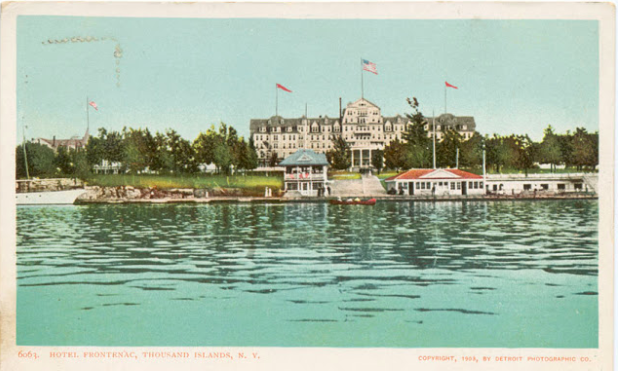
The Round Island Park Hotel was enlarged, enhanced, and renamed the Frontenac Hotel. One brochure stated that “no cheap excursions are permitted to land there,” preserving the reputation of the park for “only being for the best class of the traveling public.” The Annex to the Frontenac built in 1899 and the hotel were rebranded as the New Frontenac Hotel. The Frontenac was all about elegance and luxury. The Frontenac had an orchestra that gave regular dances, hops, and balls. Other amusements included bowling, archery, golf, and tennis. In 1900, Emery leased the yacht Gryphon to ferry his elite clientele from Clayton. Hotel guests could also charter the yacht for the day. The hotel boasted the very best fire protection. On the top story of the building, there were great iron tanks supported by iron pillars that held 23,000 gallons of water. Fire hoses and attachments were placed throughout the building as well as many hand fire extinguishers. Apparently their fire suppression equipment wasn’t as topnotch as they thought; the Frontenac Hotel burned in 1911.
Grenell Island Park
While other parks in the region were started by investment companies, Grenell Island Park was started by Sam and Lucy Grenell, who had lived, farmed, and operated a tavern on the island for 20 years before the park was incorporated in 1882. The small island was divided into 176 lots and several avenues. Grenell is about half the size of Round Island and about one third the size of neighboring Murray Isle.
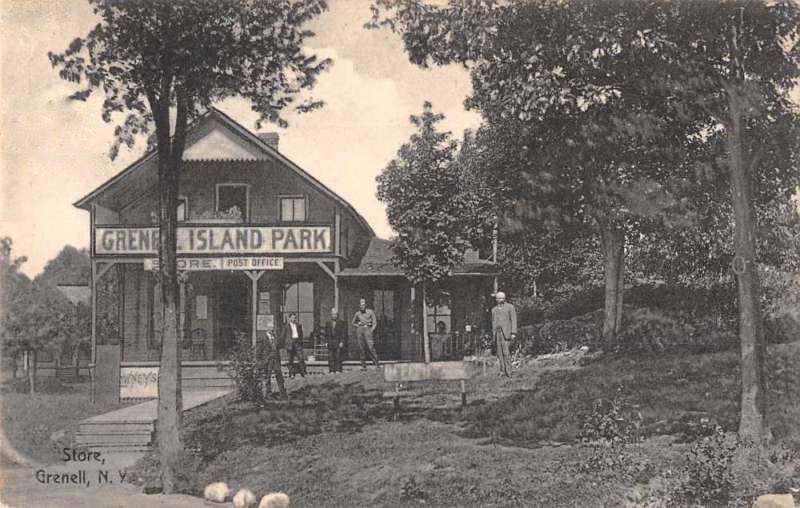

In 1889, the Grenells sold Grenell House, which stood on a tiny adjacent island that was connected to the main island by a bridge to J. I. Sayles. Sayles constructed the Pullman House, which opened the next year. In 1891, the Grenells opened a store and post office on the main island. Sam and Lucy donated a lot, and the residents of the island contributed money for the building of a chapel on the island in 1898. The Pullman House burned in 1904, the bridge fell into disrepair, and was never replaced, and the small island to the east became known as Pullman Island to local residents. (Not to be confused with Pullman Island owned by George Pullman near Alexandria Bay.) The Grenells lost control of the island due to a lawsuit. While Sam Grenell retained his cottage on the island, he lost all his other holdings, including the store. The name “Park” was removed from the store, and it became known only as the Grenell Island Store.
Palisades Park
This small park was organized but never got off the ground.

Situated at the foot of Murray, Palisades Park consisted of ten acres of land divided into 120 lots. In 1890, a dock was built back in Escanaba Bay. Palisades Park was a gorgeous site with views of the palisades on Wellesley Island on the other side of the Narrows and views over Eel Bay and the Canadian shore beyond. An 1890 On the St. Lawrence article stated that a dock and dock house for the new park were built in Escanaba Bay. Lots were sold, but as far as I can ascertain, none were built on.
Murray Hill Park
In 1890, the Thousand Island Investment Company bought all of Hemlock Island except for the 10-acre Palisades Park at the end of the island and a few other lots at the foot of the island where the Cliff House once stood.
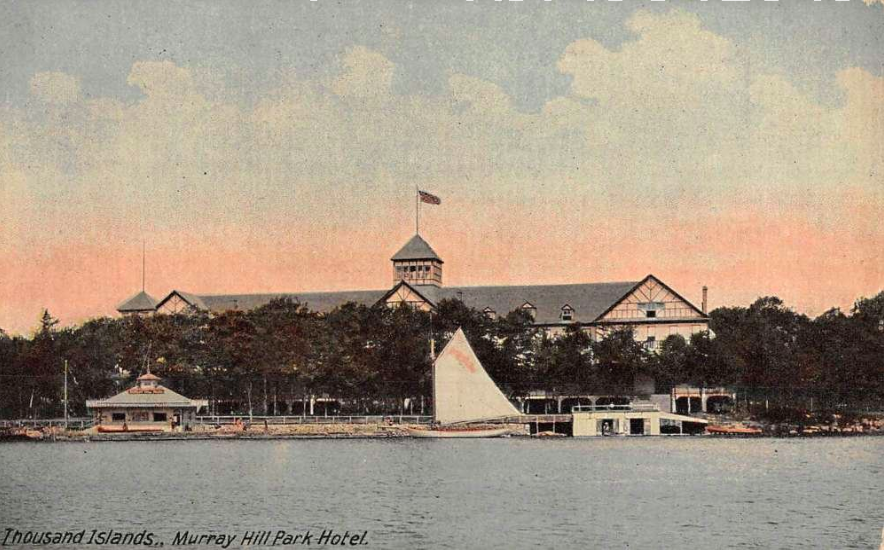
Murray Hill Park consisted of 300 acres, divided into 1,328 lots. The plans for the resort called for avenues, parks, an interior lake, and a small gauge train that would circle the island. A large boathouse was built in 1893. The hotel was built in 1895 and opened for the 1896 season. Bicycle races were all the rage at the turn of the century. Murray Hill Park constructed a bicycle track and hosted races. They were wildly popular. Various organizations held their annual conventions and meetings at the hotel. Some conventions would host as many as 440 or 500 people and stay a week or more. The American Chess Association started holding its annual chess tournaments at Murray Hill Park in 1897. The hotel was also known for its high-quality musical entertainment—both vocal and instrumental. The hotel changed hands several times between 1912 and 1923. The hotel closed in 1923. Demolition began in 1925.
Grand View Park
Consisting of 25 acres with 228 building lots, Grand View Park was established in 1885 on the northwestern point of Wellesley Island.

Grand View Park was situated mid-river on an elevated point, with Eel Bay on its south shore and the Canadian border only a stone’s throw from its north shore. Its elevated position gave it views of both the Canadian mainland to the north and the U.S. mainland to the south—hence the name “Grand View.” This Park had a “bathing beach,” which was considered to be one of the finest in the River. Mr. Hamilton Child built the Grand View Park Hotel in 1887. A bakery was built in 1890, as well as a toboggan slide at the bathing beach. The well-shaded grounds made it a popular picnic spot. An outbreak of Typhoid in 1899 was probably responsible for the demise of Grand View. Two young boys died. Charles Emery purchased the Grand View Park Hotel and twenty surrounding acres in 1903 with the plans of turning it into a “fresh air camp” for underprivileged city children. The hotel was used for one year as a camp for deaf children. In 1908, Emery moved the hotel and a few of the other buildings to Picton Island.
Thousand Island Park
According to an 1880 Watertown Times article, Thousand Island Park was the first park on the River. Organized in 1875 as a Methodist campground, most of the early residents stayed in tents.
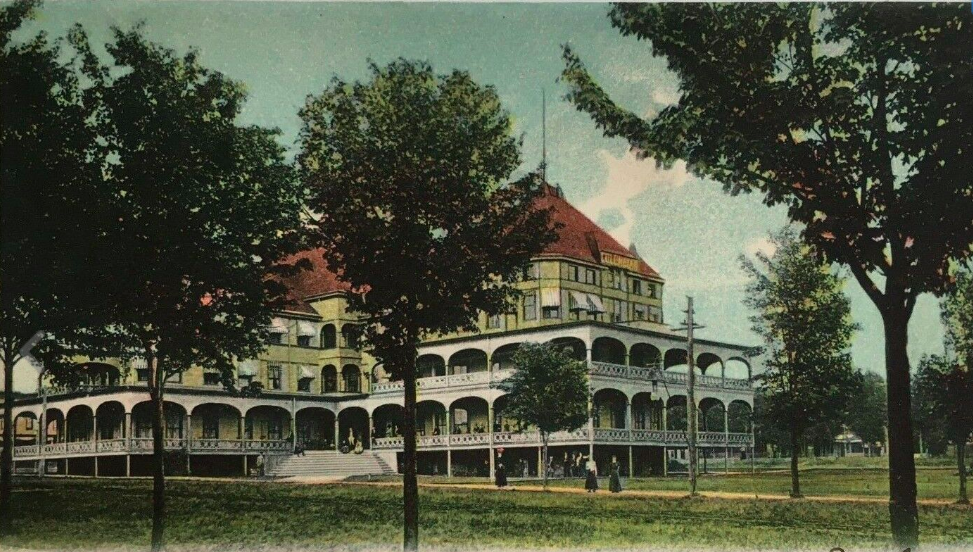
A dozen years later, the park had 300 cottages and a fine hotel—the Thousand Island Park Hotel. Early on, the tabernacle was the center of social life at the park. It was originally housed in a gigantic tent which was eventually replaced by a shed-like structure open on three sides to the cooling breezes of the St. Lawrence. By 1890, the number of cottages had doubled and the Park boasted a summer population of 7,000. After the hotel was destroyed by fire in 1890, it was replaced by the much larger and grander Columbian Hotel. The strict rules about curfew, Sunday activities, no dancing, and no card-playing, went by the wayside. The devastating fire of 1912 destroyed the Columbian, as well as hundreds of cottages and boarding houses, the chapel, and the business district. The business district was rebuilt, but many cottages were not. Thousand Island Park was listed on the National Register of Historic Places in 1982.
Fine View (Park)
While technically not named Fine View Park, it was sometimes referred to as such.


A mile downriver from Thousand Island Park this small community contained a dozen or more cottages, a hotel, a store, and a steamship dock. Fine View sprang to existence when steamers were banned from landing at Thousand Island Park on Sundays. The hotel there was initially called Wellesley House but changed its name to Fine View House in 1887 and it burned down in 1914. The Densmore Church was built in 1902.
Central Park –later known as St. Lawrence Park
Central Park was incorporated in 1881. Aptly named, as it is half-way between Alexandria Bay and Thousand Island Park.
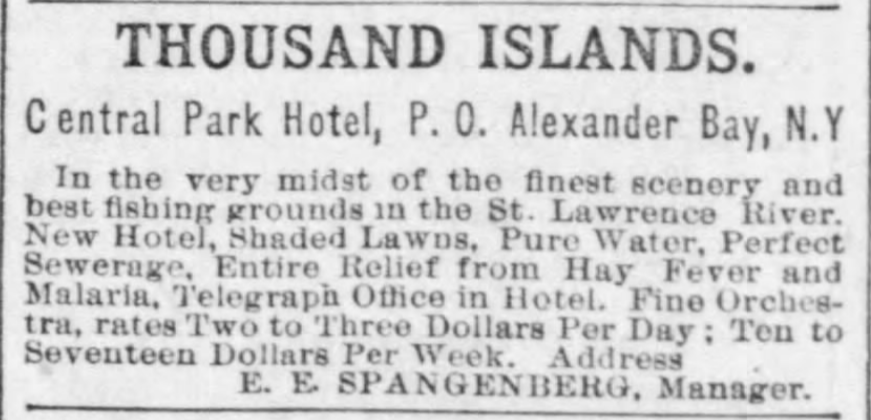
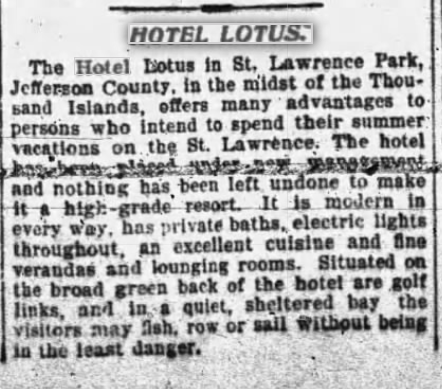
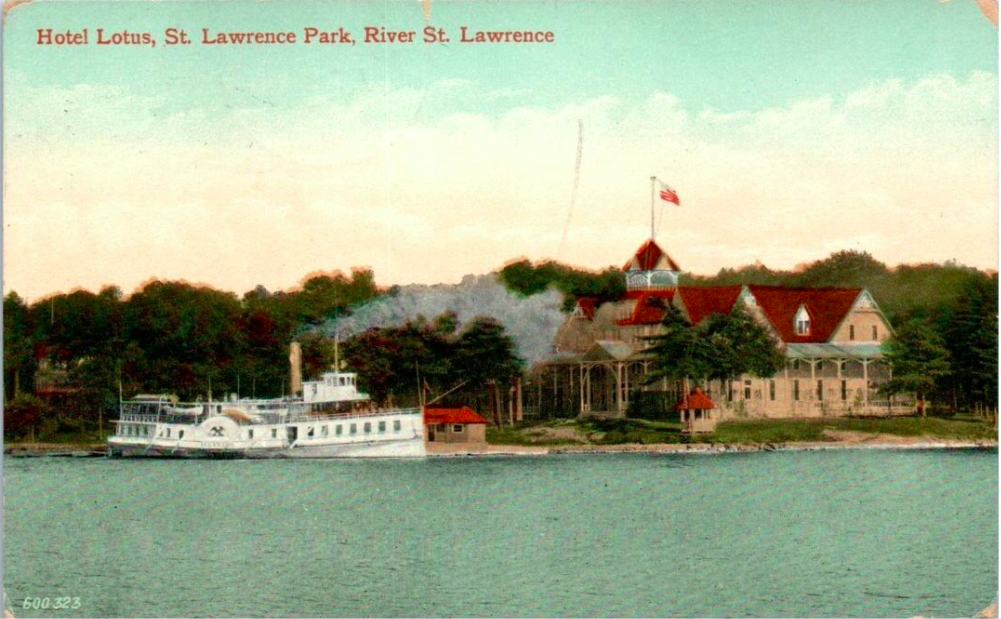
It is pleasantly situated on the mainland on a jut of land that stuck out into the St. Lawrence and well-shaded by a canopy of beech, oak, pine, hemlock and maple. The hotel at St. Lawrence Park eventually came to be called Lotus Hotel. An 1881 Watertown Times article described the hotel like this: “A large dining hall was built with good meals and reasonable rates. The Flora Holden makes the park her headquarters and runs in connection with trains at Clayton.” By 1894 it was known as St. Lawrence Park. The Lotus Hotel was the favorite haunt of the prestigious Angler’s Association. Mrs. C. H. Remington purchased the Hotel Lotus and auctioned off its contents. The property was razed in the spring of 1919 and made into a fine lawn.
Point Vivian Park
In 1877, a group of investors from Evans Mills, NY purchased a mainland peninsula situated about two miles upriver from Alexandria Bay and divided it into forty lots.
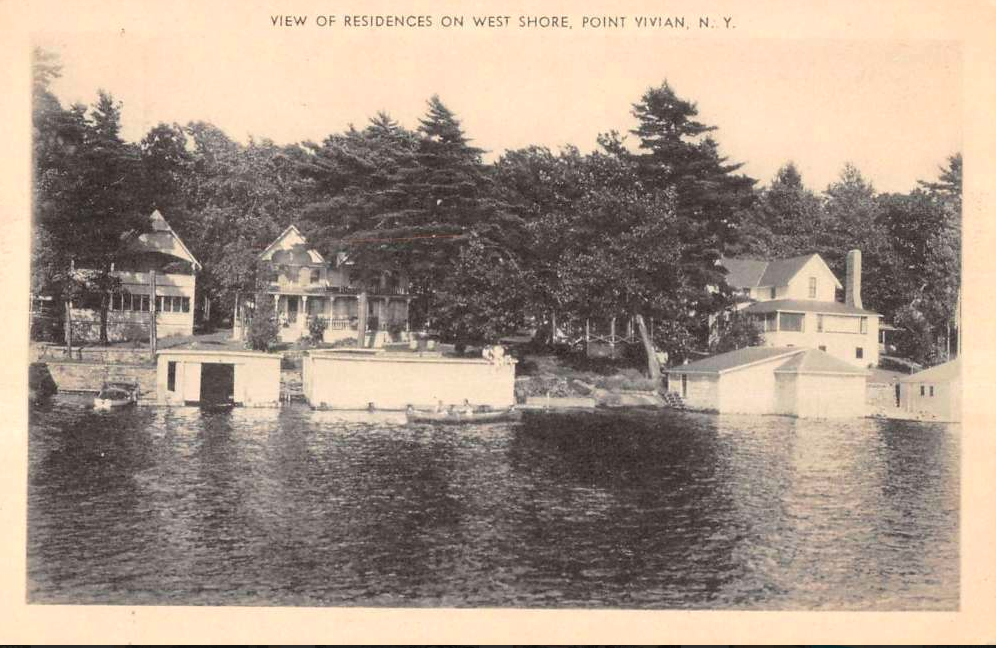
Originally named Houghton’s Point for the previous owner, the name was changed to Point Vivian. Local lore holds that Belle Ivers, daughter one of the investors, suggested the name change to Point Vivian as "Vivian" suggested “happiness or liveliness.” The park was known for its well-wooded lots and River breezes. By the early 1900s, it had a post office, ice house, and store. Its large steamboat was fronted by a common area that sported a dock house and lovely pavilion. The park was connected to Alexandria Bay and Clayton by road.
Edgewood Park
Only a two-minute row from Alexandria Bay was a quiet, restful and secluded spot known as Edgewood Park.


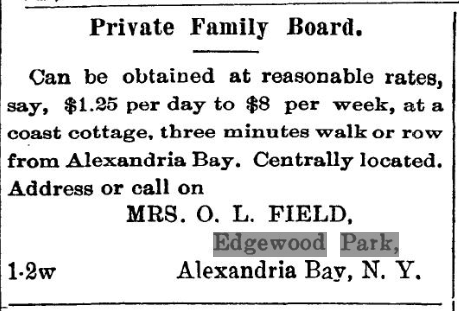
Organized in 1886 by “sixty society gentlemen” from Cleveland, Philadelphia, Chicago and Brooklyn, it had the reputation of being a place of refinement. The Edgewood Park Hotel had spacious parlors, broad shaded piazzas, and large rooms. It was known for its excellent dining room service. There was a large garden out back to supply fresh vegetables for the hotel. In addition, there was a billiard room, bowling alley, and shooting gallery. A house orchestra provided daily concerts and weekly dances were held.
This park was the only one to successfully transition from the 19th century to the 20th century, no doubt due to its proximity to the newly improved roads. In 1950, two gentlemen from Wethersfield, Connecticut, purchased the park for $65,000, which at the time included a 40-room clubhouse and annex, a half-mile race track and stables for fifty horses. It was then the name changed from Edgewood Park to Edgewood Resort. The duo staged harness races and by 1952 branched out to stock car races on what they called Edgewood International Speedway. In 1955, they opened a 60-acre “Adventure Town.” The Wild West town had “a general store, gun shop, smithy, carriage shop, stagecoach office, jail, railroad station and featured an Indian village near Lake Geronimo.”
Westminster Park
Thousand Island Park might have been the first Park on the River, but Westminster was a close second. Located nine miles from Thousand Island Park on the downriver tip of Wellesley Island, this large park was organized in 1875 by Presbyterians.

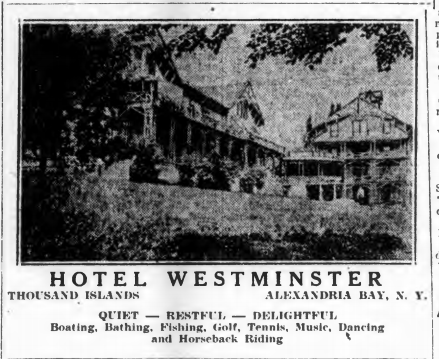
It comprised 500 acres with five miles of waterfront. The additional 25 acres of Isle Mary also known as Picnic Point (not to be confused with Picnic Point on Grindstone Island), was added later. Isle Mary was connected to the park by a bridge and reserved exclusively for excursion and picnic parties. The Westminster Park Hotel was built circa 1877 and was famous for fine food. The hotel premises included a small general store, a post office, a boat livery, a ferry slip and landing, tennis courts, a polo field, and a stable for horses. An expansive lawn and a community beach added to the park's popularity. The hotel remained in operation until 1935. It was torn down in 1941.
Tremont Island Park
The only Canadian park I came across was Tremont Island Park, located right across from Gananoque in the Admiralty Group.
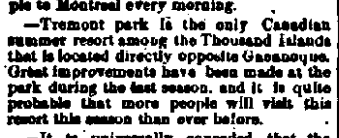
The 24-acre island, formerly known as Tidd Island, was purchased by Captain Davis in 1881 and laid out in lots. A hotel was built as well as about 35 cottages. The hotel was once owned by Alexander and Mary See. Mary is the creator of the “See’s Famous Old Time Candies.”
By Lynn E. McElfresh
Lynn McElfresh has written well over 130 articles for TI Life and each one makes this editor happy and entertains TI Life readers. This one is no exception. To see all of Lynn’s island experiences, search TI Life under Lynn McElfresh.
And as an added bonus, a few months ago, we announced Lynn's first of nine novels... Grenell 1881, Her second novel is about to be published, and being "safe at home," we suspect she is working on Novel 3.
Grenell 1881 is now on sale in several River locations. Buy it, read it and enjoy it!


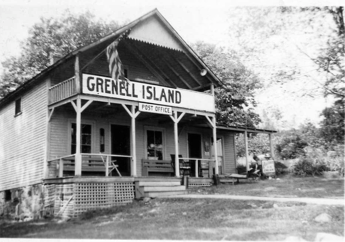

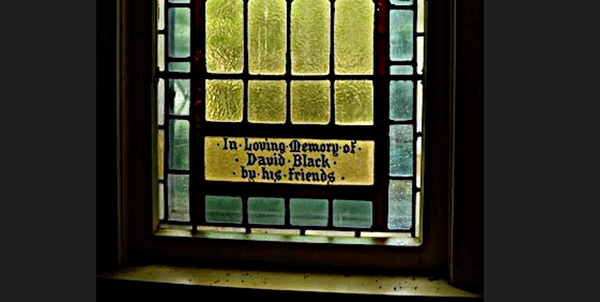
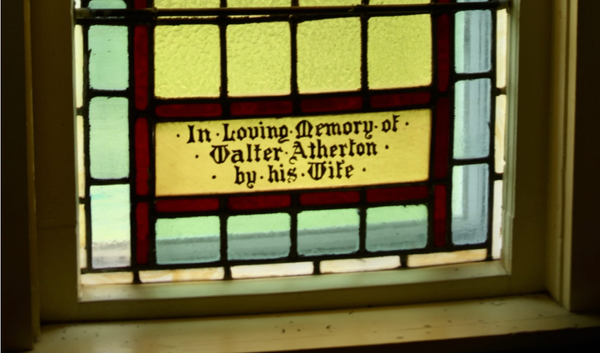
Please click here if you are unable to post your comment.